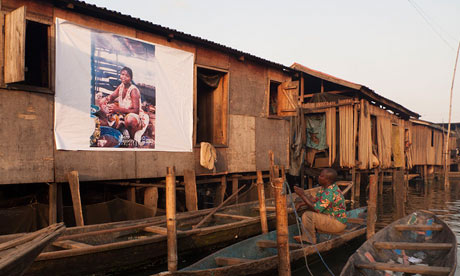| Photographers love Lagos's floating slum for its colour, canoes and poverty. But local teenagers are displaying a different side
|
|
In an exhibition on American photography in 1978, MoMA curator John Szarkowski made a distinction between photographs that offer a window to the world and photographs that reflect (mirror) the intention of its maker. An exhibition of photographs by teenagers from Makoko, a poor neighbourhood in Lagos, adds their windows to the houses built on water. Makoko is extremely photogenic thanks to two of its features – that it is partially built on water and, that most of its residents are poor. Think women wearing colourful clothes on canoes. Think naked children floating around in plastic tubs, smiling at the camera. Last year, Makoko made world news when local authorities gave orders to clear part of the waters occupied by houses on stilts. Most photographers visit Makoko once or twice. They take their pictures and publish them for an audience elsewhere for viewers to see this exotic place. Living conditions look so poor that it is not strange to be glad not to be there yourself. At the same time it is beautiful enough to want to see it. The people photographed usually do not see the photos taken, let alone the publications that feature them.
For the exhibition, Otori and Opara ran workshops for teenagers in Makoko twice a week for six-months, teaching an awareness of formal aspects of image making and the basics of photography. From the initial 15 students, five made it to the end. Works by four of them – Anthony Monday, Afose Suleiman, Mary Awajinumi, and Peter Onge – are now on show in their own neighborhood. The Silent Majority project is not novel, it is not the only initiative where children were given cameras and asked to capture images of their lives. It has happened, for example, in Nairobi when American photographer Lana Wong did 'The Shootback Project', in Calcutta where British artist Zana Briski carried out the 'Kids with Cameras' initiative, and in Brazil where British photographer Julien Germain worked with street children. I am from the Netherlands and have worked with children in the Netherlands and Uganda and arranged an exchange with photographs between them. It seems both sides get something out of this. |
 The exhibition can be seen from boats around Makoko. Photograph: Andrea Stultiens
The exhibition can be seen from boats around Makoko. Photograph: Andrea Stultiens
Commentaires